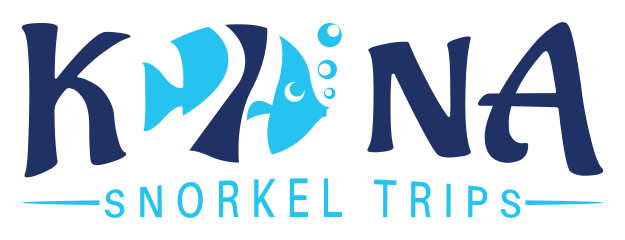Manta Ray Night Snorkel: A Magical Experience

The Magic of Manta Ray Night Snorkeling
Stepping into the ocean at night feels like discovering a hidden world. This is especially true for manta ray night snorkeling, an unforgettable experience that blends science and pure wonder. Special lighting systems, carefully placed on floating platforms or rafts, create enchanting cascades of plankton. These cascades attract graceful manta rays, which perform captivating feeding displays right in front of your eyes.
The Science Behind the Spectacle
The magic of manta ray night snorkeling comes from the fascinating relationship between light and plankton. Manta rays are filter feeders, consuming vast amounts of microscopic organisms. The lights used during these nighttime excursions mimic the moon's reflection, drawing plankton to the surface. This creates a concentrated food source for the manta rays, allowing snorkelers to observe their incredible feeding rituals up close. These platforms offer a stable viewing area and contribute to ongoing conservation efforts. Many operators prioritize sustainable practices, such as using eco-friendly lights and minimizing disruptions to the natural habitat.
Hawaii: A Manta Ray Paradise
Hawaii, especially the Big Island, offers ideal conditions for manta ray night snorkeling. The warm, clear waters provide exceptional visibility, even after sunset. The unique underwater terrain of bays like Makako Bay (Garden Eel Cove) and Keauhou Bay creates perfect feeding grounds for these gentle giants. This has made these tours increasingly popular. The docile nature of manta rays and the opportunity for close encounters draw visitors from all over the world. In fact, by August 2015, there were at least 42 commercial tour operators offering manta ray night snorkeling experiences, demonstrating the growing interest in this special activity. More detailed statistics are available here: Hawaii Manta Ray Viewing Operations Assessment
A Nighttime Transformation
The darkness transforms the underwater environment, providing a distinctly different experience from daytime snorkeling. While daytime offers glimpses of vibrant reef fish and coral, the night brings out a different cast of marine life. The plankton drawn by the lights attracts not just manta rays but also other nocturnal creatures, creating a lively and dynamic underwater scene. This, combined with the unique opportunity to witness the manta rays' feeding habits, makes night snorkeling a truly memorable adventure. The tranquility of the night amplifies the sounds of the ocean, adding another dimension to the experience. This distinct combination of factors makes manta ray night snorkeling an exceptional adventure.
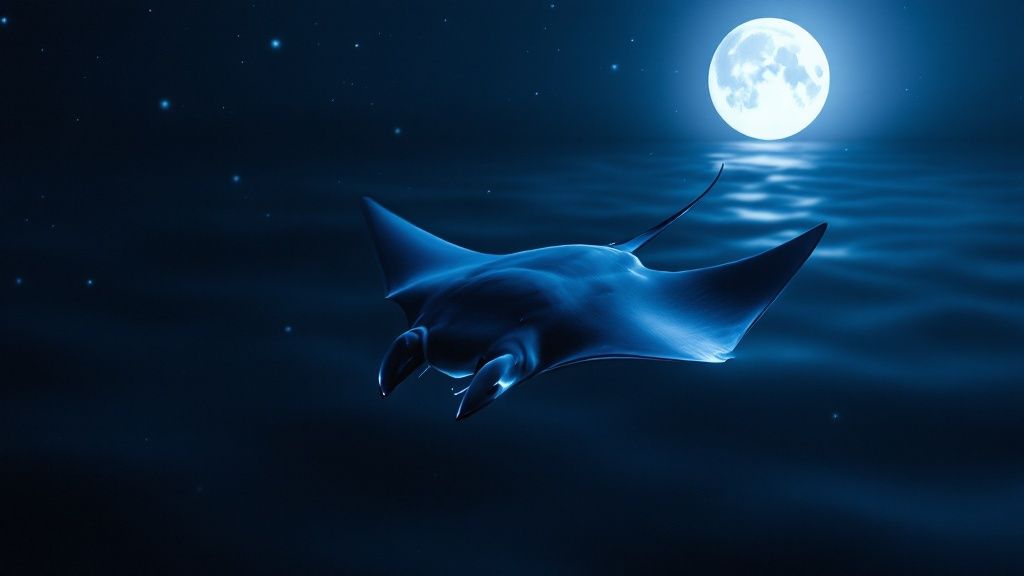
Prime Locations for Unforgettable Manta Encounters
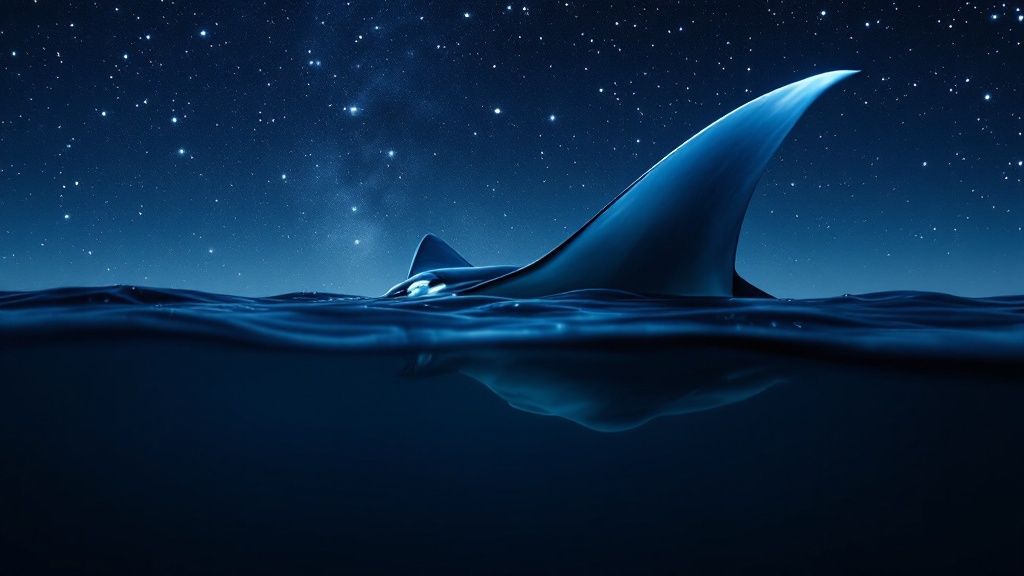
Not all manta ray night snorkeling experiences are created equal. The Big Island of Hawaii, however, stands out with some truly exceptional viewing spots. These locations are well-known for their consistent manta ray activity and the perfect environmental conditions that make them ideal feeding grounds. Let's delve into what makes these locations so special.
Makako Bay (Garden Eel Cove): A Manta Ray Hotspot
Makako Bay, also called Garden Eel Cove, offers a shallow, sandy bottom, making it perfect for manta ray night snorkeling. Its gentle slope and abundant garden eels foster a rich ecosystem teeming with plankton, the manta ray's main food source. When lights are shone on the water, the plankton rise, and the manta rays follow, creating a breathtaking spectacle for snorkelers. For other exciting Kona adventures, you might be interested in our activity sitemap.
Keauhou Bay: Where the Mantas Dance
Keauhou Bay is another fantastic location famous for reliable manta ray sightings. The bay's unique topography and consistent currents create nutrient-rich waters, supporting a thriving plankton population. This, of course, attracts large numbers of manta rays. On some nights, you can witness multiple manta rays circling and performing their graceful "barrel rolls" as they feed, a truly unforgettable ballet for those observing from above.
Beyond the Popular Spots: Hidden Gems
While Makako Bay and Keauhou Bay offer easy access and popularity, some less-traveled locations provide more intimate manta ray encounters. These hidden gems often have smaller crowds, allowing for a closer connection with these gentle giants. They may also offer unique perspectives on manta ray behavior, making them a rewarding experience for those seeking a truly special adventure.
To help you choose the best spot for your snorkeling adventure, we've compiled a table comparing some of the top locations:
To help you choose the best spot for your manta ray night snorkel adventure, we've put together a handy comparison table:
Top Manta Ray Night Snorkel Locations in Hawaii: A Comprehensive Comparison of Premier Manta Ray Viewing Locations on the Big Island
| Location | Success Rate | Best Time | Depth | Crowd Level | Notable Features |
|---|---|---|---|---|---|
| Makako Bay (Garden Eel Cove) | High | Sunset to Night | Shallow | Moderate to High | Sandy bottom, abundant garden eels |
| Keauhou Bay | High | Sunset to Night | Moderate | Moderate to High | Consistent currents, nutrient-rich waters |
| Kona Coast (various locations) | Varies | Sunset to Night | Varies | Low to Moderate | Intimate experiences, diverse underwater terrain |
This table highlights some key differences between the popular spots and some of the lesser-known locations, allowing you to choose the experience that best suits your preferences.
Manta ray night snorkeling is incredibly popular, with an estimated 80,000 people snorkeling or diving with manta rays every year. This underscores the significant interest in this activity. Tour operators often utilize high-capacity vessels, accommodating many customers on each trip. This unique encounter with nature contributes significantly to local tourism. Learn more about the impact of manta ray tourism. Choosing the right location, based on your preferences and desired level of interaction, is essential for an unforgettable manta ray experience.
What Really Happens During Your Manta Ray Experience
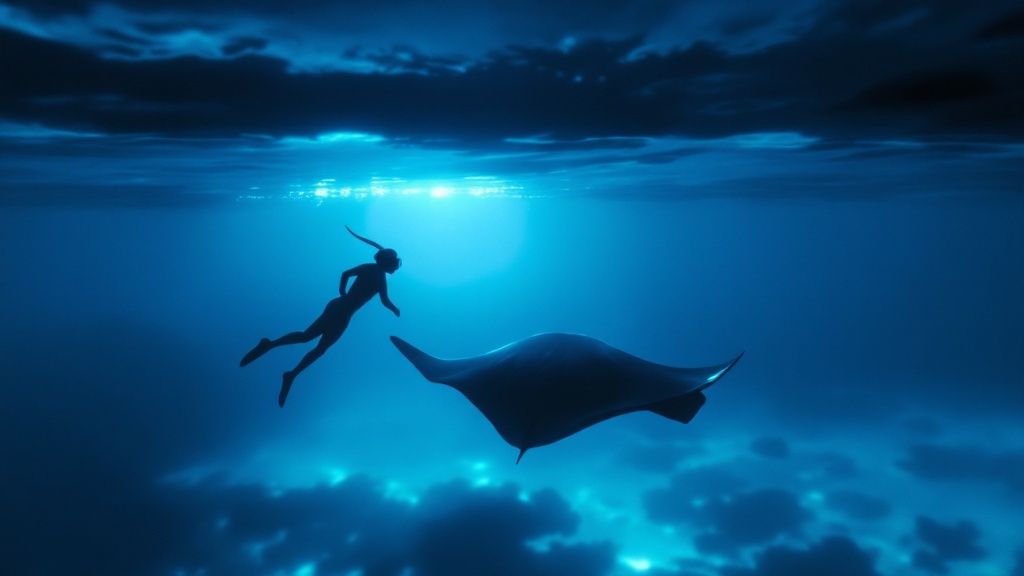
So, you're captivated by the idea of a manta ray night snorkel and want to know what to expect. Let's explore the realities of this incredible encounter. This section will uncover the factors that can influence your manta ray viewing experience, from the likelihood of sightings to the different types of encounters you might have.
Decoding the Manta Ray Sighting Probability
A successful manta ray night snorkel hinges on a delicate balance of natural factors. The Big Island offers fantastic viewing opportunities, but it's essential to have realistic expectations. These magnificent creatures are wild animals, and their behavior is governed by the environment.
Moon phases, for example, impact ambient light, affecting plankton visibility and, consequently, manta ray feeding patterns. Seasonal plankton blooms create periods of heightened manta ray activity, increasing the chances of sightings.
Ocean conditions also play a vital role. Calm, clear water provides optimal visibility, while rough seas or strong currents can make viewing more challenging. Even so, the odds of an encounter are quite good. Operators like Jack's Diving Locker report an 85-90% success rate for manta ray sightings. This impressive statistic makes the Big Island a premier destination for manta ray enthusiasts. The clear, warm waters surrounding the island further enhance visibility, creating an exceptional setting for this nighttime adventure. Learn more about manta ray sightings on the Big Island.
Types of Manta Ray Encounters: From Glimpses to Grand Spectacles
Every manta ray encounter is unique. You might catch a quick glimpse of a manta in the distance, gracefully gliding through the dark water. Even a brief sighting can be thrilling, especially for first-time snorkelers.
Under ideal conditions, however, you might witness a breathtaking display of manta rays performing their iconic barrel rolls mere inches from your mask. These close encounters are what truly make a manta ray night snorkel an unforgettable experience.
Seasonal Variations and Authentic Visitor Experiences
The time of year you choose for your manta ray adventure can also shape your experience. During peak season, usually the summer months, calmer waters and plentiful plankton often lead to increased manta ray activity. This means a greater chance of seeing multiple manta rays feeding at once.
The off-season, conversely, might offer smaller groups of manta rays, providing a more intimate experience, though sightings might be less frequent. Reviewing visitor experiences from different seasons can help you set realistic expectations and choose the best time for your adventure. This preparation can significantly enhance your chances of a truly memorable manta ray encounter.
Selecting Your Ideal Manta Ray Night Snorkel Tour
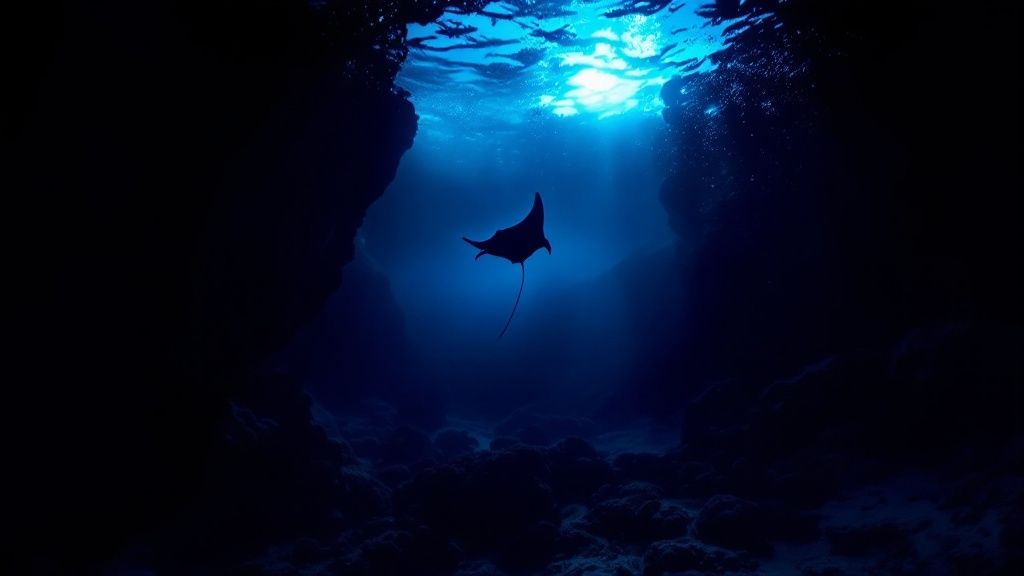
With manta ray night snorkeling becoming increasingly popular, finding the perfect tour can be a bit daunting. This guide will help you navigate the various options, from affordable group tours to more exclusive private charters. We’ll give you the information you need to make a smart choice that fits both your budget and your priorities. For more resources, check out our sitemap.
Beyond the Price Tag: Group Tours Vs. Private Charters
Group tours are a popular option for budget-minded travelers. They offer a lower price point, but the larger group size can sometimes affect the overall experience. You may receive less individual attention from the guides, and viewing conditions can become crowded. The tour pace also caters to the entire group, which can limit flexibility.
Private charters offer a more personalized and premium experience. While more expensive, the smaller group size allows for greater interaction with guides and more opportunities to ask questions. You’ll also enjoy a more flexible itinerary, tailored to your interests and preferred pace.
Key Questions to Ask Your Tour Operator
Choosing a great tour goes beyond simply deciding between group and private options. Asking the right questions can help you find truly exceptional tour operators. Start by inquiring about the guides' experience and marine knowledge. This directly impacts the educational value and safety of your tour.
Sustainable practices are also key. Responsible operators minimize their environmental impact through eco-friendly lights and adhere to responsible wildlife interaction guidelines. These practices help protect the manta ray population and their habitat. Don’t forget to ask about safety protocols, including emergency procedures and equipment standards, to ensure a secure and enjoyable trip.
Equipment, Group Size, and Responsible Wildlife Interaction
A reputable tour operator should provide all essential equipment such as wetsuits, snorkels, masks, and flotation devices. These items are crucial for your comfort and enjoyment, particularly during a night snorkel. Be sure to inquire about the maximum group size for each tour. Smaller groups generally lead to a more intimate experience and increase your chances of close manta ray encounters.
Choosing an operator that values responsible wildlife interaction is paramount. Ask about their guidelines for maintaining a respectful distance from the manta rays. A good operator will emphasize avoiding contact, which can disrupt the manta rays’ natural behavior and harm their delicate mucous layer.
Comparing Manta Ray Night Snorkel Tours
The table below summarizes the key factors to consider when selecting a tour. Use it as a starting point to compare options and find the best fit for your needs:
To help you visualize the different options, here's a quick breakdown:
Manta Ray Night Snorkel Tour Comparison: Detailed breakdown of tour options, value considerations, and experience differences
| Tour Type | Average Price | Group Size | Equipment Provided | Duration | Extras | Best For |
|---|---|---|---|---|---|---|
| Group Tour | $90 – $150 | 10-25 | Wetsuit, Mask, Snorkel | 1-2 hours | Snacks, Drinks | Budget travelers, social groups |
| Private Charter | $300+ | 2-6 | Full Snorkel Gear | 2-3 hours | Personalized Itinerary | Families, small groups, personalized experience |
This comparison highlights the key differences and helps you weigh the pros and cons of each tour type. Choosing the right tour will ensure a magical and memorable manta ray night snorkel experience.
Understanding Manta Ray Behavior Patterns
Manta rays, often called the "gentle giants of the ocean," display captivating behaviors that make manta ray night snorkeling a truly memorable experience. These behaviors aren't random; they follow distinct patterns influenced by several key factors. Understanding these factors transforms a simple snorkel into an educational adventure.
Identifying Individual Manta Rays: Underwater Fingerprints
One of the most remarkable aspects of manta ray research is the ability to identify individual animals. Their unique ventral spot patterns, much like our fingerprints, allow marine biologists to track individuals over time. This method provides valuable data for population monitoring and conservation assessments, helping researchers understand population dynamics and the long-term health of manta ray populations.
This meticulous tracking allows scientists and conservationists to understand population trends, migration routes, and the overall health of manta ray communities.
Seasonal Migrations and Behavioral Shifts
Manta ray movements around Hawaiian waters are dynamic, following a complex seasonal rhythm. Peak months for certain behaviors, like feeding or courtship displays, vary throughout the year. Understanding these seasonal variations helps you time your manta ray night snorkel for the best possible viewing experience.
For instance, seasonal plankton blooms create concentrated feeding areas, resulting in incredible displays of manta rays circling and performing their iconic barrel rolls. For more trip-planning information, you might be interested in: Our blog post archive.
The Influence of Environmental Factors
Several environmental factors influence manta ray behavior and movement. Water temperature is key, as mantas prefer specific temperature ranges. Current patterns also dictate where plankton concentrates, influencing manta ray movements as they follow these nutrient-rich currents. The concentration of plankton itself directly impacts manta ray feeding activity, making areas with abundant plankton hotspots for sightings.
Manta ray sightings are more than just chance encounters; they follow discernible patterns. Research, such as that conducted by Manta Ray Advocates between 2009 and 2014, demonstrates how consistent data collection helps predict where larger numbers of manta rays are likely to be found. See more detailed statistics here: Manta Ray Statistics. This understanding helps tour operators optimize viewing times, contributing to responsible tourism by minimizing disruptions to the manta rays' natural habitat. It also allows snorkelers to plan strategically, increasing their chances of a truly remarkable encounter.
Preparing For Your Magical Manta Ray Encounter
Transforming your manta ray night snorkel from simply "good" to truly unforgettable depends on proper preparation. This guide covers everything from ensuring you're physically ready to adapting your gear and mindset for a magical nighttime ocean experience.
Physical Readiness and Swimming Confidence
While you don't need to be an Olympic swimmer, a basic level of comfort in the water is essential. If you haven't snorkeled recently, practice in a pool or calm shallows beforehand. This will build your confidence and familiarize you with using a snorkel and mask. Improving your physical fitness will also help you navigate currents and enjoy the experience without fatigue.
Essential Gear Modifications: Preparing Your Equipment
The right gear can significantly enhance your comfort and enjoyment. A wetsuit, even in Hawaii's warm waters, is crucial for night snorkeling, as water temperatures can drop after sunset. A 3mm thickness is often recommended for optimal warmth without restricting movement. Anti-fog solution for your mask is a must. Apply it thoroughly before entering the water and consider a spit-shine as backup. Finally, a pool noodle can provide extra buoyancy and help conserve energy, especially for less confident swimmers.
Mental Preparation: Conquering Nighttime Ocean Anxieties
For many, the most daunting aspect of a manta ray night snorkel is overcoming anxiety about being in open water at night. Visualizing the experience beforehand, focusing on the beauty of the manta rays and the excitement of the encounter, can significantly reduce apprehension. Deep breathing exercises can also help calm nerves and promote relaxation once you're in the water.
Practical Tips For Comfort and Confidence
Several practical steps can further enhance your experience. Practice water entry techniques in a pool to minimize any initial discomfort. Adjust your breathing rhythm to the snorkel, focusing on slow, deep breaths to prevent hyperventilation. If you're prone to seasickness, consider taking motion sickness medication or using acupressure wristbands specifically designed for ocean conditions.
Choosing the right tour operator can greatly influence your overall experience. Ensure your chosen operator prioritizes safety, provides high-quality equipment, and adheres to responsible wildlife viewing practices. Reputable operators like Jack's Diving Locker emphasize responsible interactions with manta rays, improving both the experience and the long-term well-being of these gentle giants. Interestingly, they have a high sighting success rate of 85-90%, making a magical encounter very likely. You can learn more at Jack's Diving Locker's Manta Ray Report.
By addressing both your physical and mental preparedness, you'll be able to fully immerse yourself in the wonder of this experience and witness the mesmerizing display of manta rays feeding beneath the stars. Ready for your unforgettable manta ray night snorkel adventure? Book your tour with Kona Snorkel Trips today! We are Hawaii's highest-rated snorkel company, committed to providing exceptional and personalized marine experiences. Book your Kona Snorkel Trip now!
